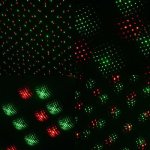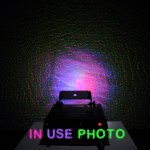- Joined
- Oct 26, 2008
- Messages
- 33
- Points
- 0
Hi there, last night I went to a party, which had a cheap $30 red/green laser projector that displayed various patterns across and into our crowd last night. The projector was located in the corner of the room, and has a 50mW green and 100mW red that are heavily diffracted. There was no actual "scanning" going on, that is, rapid XY shifting of a single beam. The lasers themselves were shown through two grid-matrix diffraction gratings that split the two continuous beams into ~400 beams.
That laser projector can be seen at this link:
Amazon.com: Green Red laser Stage Lighting Light DJ Christmas Party: Musical Instruments
Now, obviously, 50mW and 100mW are very damaging to the human eye. However, these beams have been so split up, that the power per beam should be much, much lower. On top of that, passing through the two gratings caused a little divergence for each beam. The projector was at least 15 feet from any persons eyes, and persons rarely stare directly into the projector.
Every post I read titled, "Is this safe", the answers are always the same. You need very advanced calculations, only professional installers should be audience scanning, legaleze (I'm not getting a permit for my house), a lot of knowledge about a very specific setup is required, it's only 'safer', and horror stories of such scanning going wrong. This does not deal with very powerful (200mW< or multi-Watt) lasers, this is for a common house party. There is no way you can just tell me, "yes, this is safe" or "no, it is not safe", and I'm not looking for that, here is my question.
The setup I want to be using.
The laser projector located at:
Double Laser DMX Projector (Sound Activated, Cloud Background)
100mW Red and 50mW Green laser [CVLC-G198] - US$101.55 : Ankaka.com has two continuous lasers, a 100mW red and 50mW green, containing two diffraction gratings to disperse the patterns. The split up beams (this has more splitting-up than the first link) are continuously moving. I will myself place an infrared blocking plate over the projector, as well as a diverging lens (basically, a double concave lens) to spread out each projected beam so it not only looks better, but is more safe. I can't get hard J^cm2 numbers since I don't own expensive measuring equipment, but each dot wouldn't be a very tight beam.
So now, how "safe" or "stupidly-confident" does this setup sound?
That laser projector can be seen at this link:
Amazon.com: Green Red laser Stage Lighting Light DJ Christmas Party: Musical Instruments
Now, obviously, 50mW and 100mW are very damaging to the human eye. However, these beams have been so split up, that the power per beam should be much, much lower. On top of that, passing through the two gratings caused a little divergence for each beam. The projector was at least 15 feet from any persons eyes, and persons rarely stare directly into the projector.
Every post I read titled, "Is this safe", the answers are always the same. You need very advanced calculations, only professional installers should be audience scanning, legaleze (I'm not getting a permit for my house), a lot of knowledge about a very specific setup is required, it's only 'safer', and horror stories of such scanning going wrong. This does not deal with very powerful (200mW< or multi-Watt) lasers, this is for a common house party. There is no way you can just tell me, "yes, this is safe" or "no, it is not safe", and I'm not looking for that, here is my question.
The setup I want to be using.
The laser projector located at:
Double Laser DMX Projector (Sound Activated, Cloud Background)
100mW Red and 50mW Green laser [CVLC-G198] - US$101.55 : Ankaka.com has two continuous lasers, a 100mW red and 50mW green, containing two diffraction gratings to disperse the patterns. The split up beams (this has more splitting-up than the first link) are continuously moving. I will myself place an infrared blocking plate over the projector, as well as a diverging lens (basically, a double concave lens) to spread out each projected beam so it not only looks better, but is more safe. I can't get hard J^cm2 numbers since I don't own expensive measuring equipment, but each dot wouldn't be a very tight beam.
So now, how "safe" or "stupidly-confident" does this setup sound?
Attachments
Last edited:







